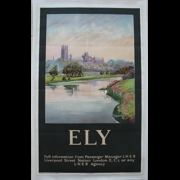Conservation
Conservation of Vintage Posters
We have some of our posters professionally conserved by a studio in London. They use entirely acid-free materials, get the paper fully wet before starting to ensure even stretch and shrinkage, and back posters onto a thin layer of Japanese tissue on-top of unbleached cotton linen for flexibility and stability.
Restoration work is undertaken on some posters (from fold-wear resulting in a slight loss of surface colour, to reinstatement of paper-loss), with watercolour pencils used to infill any coloured parts requiring work. Air-brushing with acrylics is never used by us - ocasionally we may aquire a poster where this been done by a previous owner, and we will state this fact.
Where there is some paper-loss, these are carefully infilled with fragments of paper from scrap posters of a similar age and type.
Stains within the paper (rust, water etc) are the biggest problem, with old sellotape being the worst of them all, where it can soak through the paper completely, leaving it almost transparent. These are the most difficult areas to cover up using reversible methods, so sometimes there may be some remaining stains.
All the work undertaken by us is entirely reversible if ever required, and does no harm to the original poster.
Note: If a poster was acquired already backed, we will state so in the description, and we have no knowledge of exactly what processes were undertaken, so we can only describe based on our experience.
We have some of our posters professionally conserved by a studio in London. They use entirely acid-free materials, get the paper fully wet before starting to ensure even stretch and shrinkage, and back posters onto a thin layer of Japanese tissue on-top of unbleached cotton linen for flexibility and stability.
Restoration work is undertaken on some posters (from fold-wear resulting in a slight loss of surface colour, to reinstatement of paper-loss), with watercolour pencils used to infill any coloured parts requiring work. Air-brushing with acrylics is never used by us - ocasionally we may aquire a poster where this been done by a previous owner, and we will state this fact.
Where there is some paper-loss, these are carefully infilled with fragments of paper from scrap posters of a similar age and type.
Stains within the paper (rust, water etc) are the biggest problem, with old sellotape being the worst of them all, where it can soak through the paper completely, leaving it almost transparent. These are the most difficult areas to cover up using reversible methods, so sometimes there may be some remaining stains.
All the work undertaken by us is entirely reversible if ever required, and does no harm to the original poster.
Note: If a poster was acquired already backed, we will state so in the description, and we have no knowledge of exactly what processes were undertaken, so we can only describe based on our experience.










